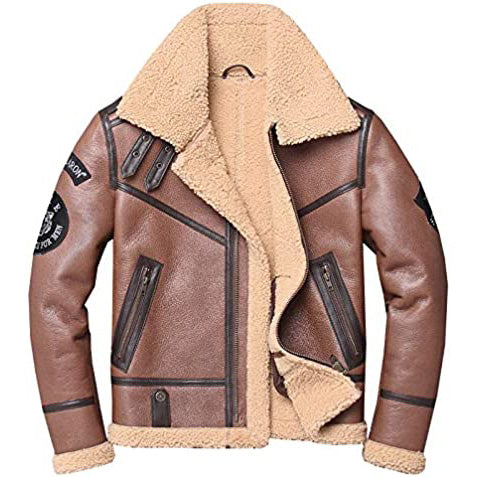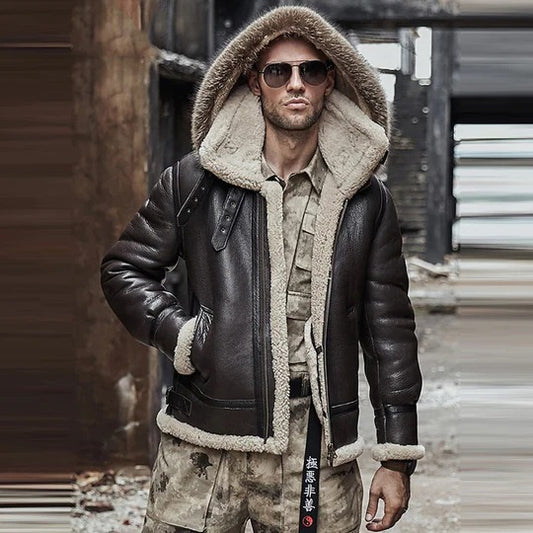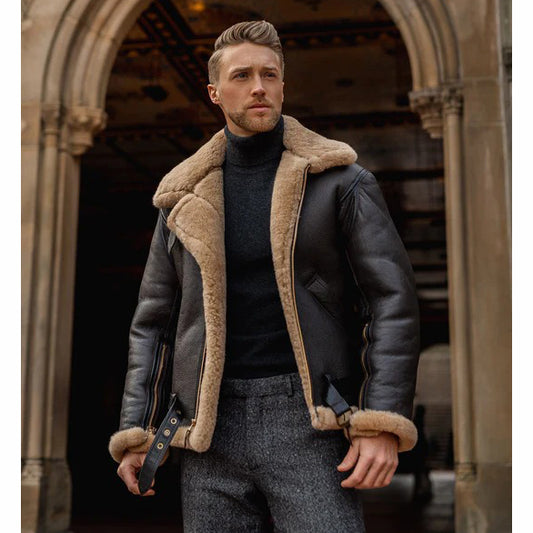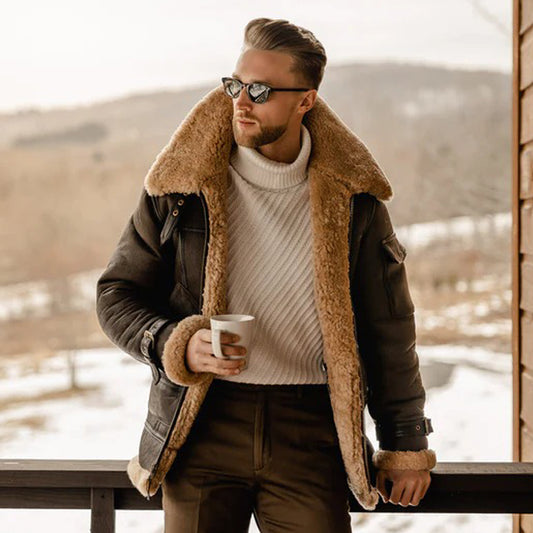1. Why Wool Matters for Peacoats
Wool is the gold standard for peacoats, and for good reason. Its natural fibers offer exceptional warmth, breathability, and moisture resistance, making it ideal for cold, damp climates. Unlike synthetic materials, wool insulates even when wet, ensuring you stay comfortable in unpredictable weather. The durability of wool means your peacoat will maintain its shape and appearance for years, resisting pilling and wear. Wool’s natural lanolin also provides a degree of water repellency, which is crucial for outerwear. When shopping for a peacoat, prioritizing wool ensures you get a garment that is both functional and stylish. Jackets Kingdom recommends wool for its timeless appeal and proven performance, making it the top choice for anyone seeking a reliable winter coat.
2. Types of Wool Used in Peacoats
Not all wool is created equal. The most common types used in peacoats include merino wool, cashmere, and lambswool. Merino wool is prized for its softness and fine fibers, offering comfort without bulk. Cashmere, though more expensive, provides unmatched luxury and warmth, making it a premium option for those seeking elegance. Lambswool, sourced from young sheep, is softer and lighter than regular wool, ideal for those with sensitive skin. Some peacoats use recycled wool, which is eco-friendly but may lack the softness of virgin fibers. Understanding these types helps you choose a peacoat that matches your needs for warmth, comfort, and budget. Always check the label to know exactly what you’re getting.
3. Understanding Wool Blends
Wool blends are increasingly popular in modern peacoats. Blending wool with fibers like polyester, nylon, or cashmere can enhance durability, reduce cost, and improve comfort. For example, a wool-polyester blend offers increased resistance to wrinkles and shrinkage, making maintenance easier. However, too much synthetic content can compromise the natural benefits of wool, such as breathability and warmth. The ideal blend for a peacoat is typically 70-80% wool, ensuring you retain the core qualities of the fabric while benefiting from added strength and flexibility. Jackets Kingdom recommends checking the blend ratio to ensure you’re getting a coat that balances performance and value.
4. Wool Weight and Warmth: What to Look For
The weight of wool fabric directly impacts the warmth and drape of a peacoat. Wool is measured in ounces per yard or grams per square meter (GSM). For peacoats, a fabric weight of 16-32 ounces per yard or 400-800 GSM is ideal. Heavier wool provides more insulation, making it suitable for harsh winters, while lighter wool is better for milder climates or layering. It’s important to consider your local weather and how you plan to wear the coat. A well-chosen wool weight ensures your peacoat is both comfortable and practical, offering the right balance of warmth and mobility.
5. How to Identify High-Quality Wool
High-quality wool is characterized by its softness, density, and resilience. When shopping, feel the fabric—premium wool should feel smooth, not scratchy. Look for a tight, even weave, which indicates durability and resistance to pilling. Check for certifications like Woolmark, which guarantees the wool meets strict quality standards. Inspect the label for the wool content and origin; reputable brands like Jackets Kingdom are transparent about their materials. High-quality wool will also have a natural luster and bounce back when pressed. Investing in superior wool ensures your peacoat remains stylish and functional for years.
6. The Role of Weave and Finish in Wool Fabrics
The weave and finish of wool fabric play a crucial role in the look and performance of a peacoat. Common weaves include twill, herringbone, and melton. Melton wool, with its dense, felted finish, is especially popular for peacoats due to its wind resistance and smooth appearance. Twill and herringbone offer distinctive patterns and textures, adding visual interest. The finish, such as brushed or felted, affects the softness and water resistance of the fabric. A well-chosen weave and finish not only enhance the coat’s durability but also its style, making your peacoat a standout piece in any wardrobe.
7. Comparing Pure Wool vs. Wool Blends
Choosing between pure wool and wool blends depends on your priorities. Pure wool peacoats offer maximum warmth, breathability, and a classic feel. They are often more expensive but provide superior insulation and longevity. Wool blends, on the other hand, are more affordable and can be easier to care for, thanks to the addition of synthetic fibers. However, blends may not offer the same level of warmth or natural feel as pure wool. For those seeking a balance between cost and performance, a high-percentage wool blend (at least 70% wool) is a smart choice. Jackets Kingdom offers both options, ensuring there’s a peacoat for every preference.
8. Caring for Your Wool Peacoat
Proper care extends the life of your wool peacoat. Always follow the care label instructions—most wool coats require dry cleaning to maintain their shape and texture. For minor stains, spot clean with a damp cloth and mild detergent. Use a soft brush to remove surface dirt and lint. Store your peacoat on a wide, padded hanger to prevent stretching, and keep it in a breathable garment bag during off-seasons. Avoid exposing wool to direct sunlight for extended periods, as this can cause fading. Regular care ensures your peacoat remains a stylish and functional staple for years.
9. Common Mistakes When Choosing Wool for Peacoats
Many shoppers make avoidable mistakes when selecting wool for peacoats. One common error is prioritizing price over quality, leading to coats that wear out quickly or fail to provide adequate warmth. Another mistake is overlooking the blend ratio—too much synthetic fiber can compromise the coat’s performance. Ignoring the fabric weight can result in a peacoat that’s either too heavy or too light for your needs. Failing to check the weave and finish may leave you with a coat that lacks durability or style. By being aware of these pitfalls, you can make a more informed and satisfying purchase.
10. Where to Buy the Best Wool Peacoats
Finding a reputable retailer is essential for purchasing a high-quality wool peacoat. Look for brands that are transparent about their materials and manufacturing processes. Jackets Kingdom, for example, offers a curated selection of wool peacoats made from premium fabrics, ensuring both style and substance. Check for customer reviews, return policies, and after-sales support. Shopping from established brands or specialty stores increases the likelihood of getting a genuine, long-lasting product. Online platforms often provide detailed product descriptions and fabric information, making it easier to compare options and make an informed decision.
Frequently Asked Questions
1. What is the best type of wool for a peacoat?
Merino wool is highly recommended for its softness and warmth, but melton wool is also popular for its durability and wind resistance.
2. Are wool blends as good as pure wool for peacoats?
Wool blends can offer added durability and affordability, but pure wool provides superior warmth and breathability.
3. How can I tell if a wool peacoat is high quality?
Check for a tight weave, smooth texture, and certifications like Woolmark. High-quality wool should feel soft and resilient.
4. What is the ideal wool weight for a peacoat?
A weight of 16-32 ounces per yard or 400-800 GSM is ideal for most climates, balancing warmth and comfort.
5. How should I care for my wool peacoat?
Dry clean as recommended, spot clean minor stains, and store on a padded hanger in a breathable garment bag.
6. Is cashmere a good choice for peacoats?
Cashmere offers luxury and warmth but is more delicate and expensive than other wools.
7. Can I wear a wool peacoat in the rain?
Wool is naturally water-resistant, but prolonged exposure to heavy rain can damage the fabric. Use an umbrella or raincoat for protection.
8. What are the benefits of melton wool?
Melton wool is dense, wind-resistant, and has a smooth finish, making it ideal for peacoats.
9. Are recycled wool peacoats a good option?
Recycled wool is eco-friendly but may not be as soft or durable as virgin wool.
10. Where can I buy high-quality wool peacoats?
Jackets Kingdom offers a range of premium wool peacoats, with transparent sourcing and quality assurance.
Make the Right Choice: Shop Quality Wool Peacoats at Jackets Kingdom
Choosing the best wool fabric for a peacoat is an investment in warmth, style, and durability. By understanding the different types of wool, blends, weights, and care requirements, you can select a peacoat that meets your needs and stands the test of time. Jackets Kingdom is committed to offering only the finest wool peacoats, ensuring you stay comfortable and stylish all winter long. Explore our collection today and experience the difference that quality wool makes.




